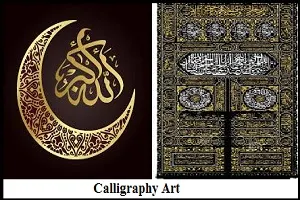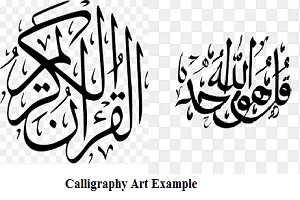Calligraphy art, an ancient yet timeless art form, has fascinated humanity for centuries. From east to west, from the past to the present, calligraphy has been one of the most revered forms of art worldwide. More than just arranging letters, calligraphy presents captivating visual beauty and profound depths of meaning.
A Long History of Calligraphy
Calligraphy has deep roots in various cultures around the world. Its history spans continents and ages, from ancient Chinese calligraphy to Arabic, Persian, and European calligraphy. However, one of the peaks of calligraphy development occurred in the Islamic world, where the art of writing evolved into the highly esteemed art of calligraphy.
Cultural Expression and Spirituality
In the Islamic context, calligraphy plays a significant role as it is used to write verses from the Quran, the holy book of Islam. Therefore, calligraphy is not just a visual art but also an expression of spirituality and admiration for the greatness of God. Every curve of the letter and stroke of the ink not only reflects visual beauty but also radiates depth of meaning and spiritual power.
Techniques and Styles
In practice, calligraphy involves the use of various techniques and diverse styles. From khat (Arabic calligraphy style) to naskh (Persian calligraphy style) and kai (Chinese calligraphy style), each style has its own uniqueness and beauty. Calligraphy artists often spend years mastering specific techniques and styles, creating stunning and inspiring works.
Influence in Contemporary Art
Although calligraphy originated in the past, its influence remains strong in contemporary art. Many modern artists are inspired by calligraphy in their works, whether in paintings, digital art, or graphic design. Calligraphy not only forms part of cultural heritage but also serves as an endless source of inspiration for contemporary artists.
Preserving Tradition and Innovation
In this modern era, it is important to preserve the tradition of calligraphy while also creating space for innovation and experimentation. By combining traditional techniques with contemporary approaches, we can ensure that calligraphy remains alive and relevant amidst changing times.
Calligraphy Art Example
Here's an example of calligraphy art accompanied by a brief description:
Calligraphy Art Example
Description:
This piece of calligraphy art features elegant Arabic script meticulously written in black ink on textured off-white paper. The flowing curves and intricate details of the letters create a sense of harmony and balance. The words chosen are verses from the Quran, adding spiritual depth to the artwork. The overall composition exudes a timeless beauty and evokes a sense of reverence.
Facts about calligraphy art
Here are some facts about calligraphy art:
1. Ancient Origins
Calligraphy has ancient origins, dating back thousands of years to civilizations such as China, Egypt, and Mesopotamia.
2. Islamic Influence
Calligraphy became highly revered in the Islamic world, particularly for its use in transcribing the Quran. It developed into an esteemed art form known as "khatt Islami" or Islamic calligraphy.
3. Spiritual Significance
In Islamic culture, calligraphy holds spiritual significance as it is often used to depict verses from the Quran. The act of writing these sacred words is considered a form of devotion.
4. Diverse Styles
Calligraphy encompasses a wide range of styles and scripts, including Arabic, Persian, Chinese, and Western styles. Each style has its own unique characteristics and history.
5. Technical Skill
Mastering calligraphy requires a high level of technical skill and precision. Artists must learn proper penmanship, stroke techniques, and letterforms to create beautiful and legible compositions.
6. Cultural Significance
Calligraphy is deeply intertwined with the cultural identity of many societies. It is often used in official documents, religious texts, and ceremonial artworks, reflecting the importance placed on written language.
7. Contemporary Revival
While traditional calligraphy remains highly valued, there has been a resurgence of interest in calligraphy as a contemporary art form. Modern artists experiment with new techniques, materials, and themes, pushing the boundaries of the art form.
8. Global Influence
Calligraphy has influenced various art forms beyond writing, including painting, typography, and graphic design. Its aesthetic principles and emphasis on balance and harmony have left a lasting impact on visual arts worldwide.
In conclusion, calligraphy art is a journey through time and space, revealing beauty and profound meaning in every stroke of ink. From the grandeur of the Quran to the works of contemporary artists, calligraphy continues to fascinate and inspire us, reminding us of the magnificence of art and the cultural richness left behind by human civilization.
That is the article entitled Beauty of Calligraphy Art. If there are any deficiencies or errors in writing this article, the Pustaka Pengetahuan expresses its deepest apologies. Please leave a wise message in the comments column provided. Thank you for visiting, hopefully it's useful.
Other reading materials, can help with school assignments, click Berbagai Reviews
To increase insight and knowledge, please click Baraja Farm
For tutorial on how to cultivate, please click Baraja Farm Channel
Social media please click facebook


Tidak ada komentar:
Posting Komentar